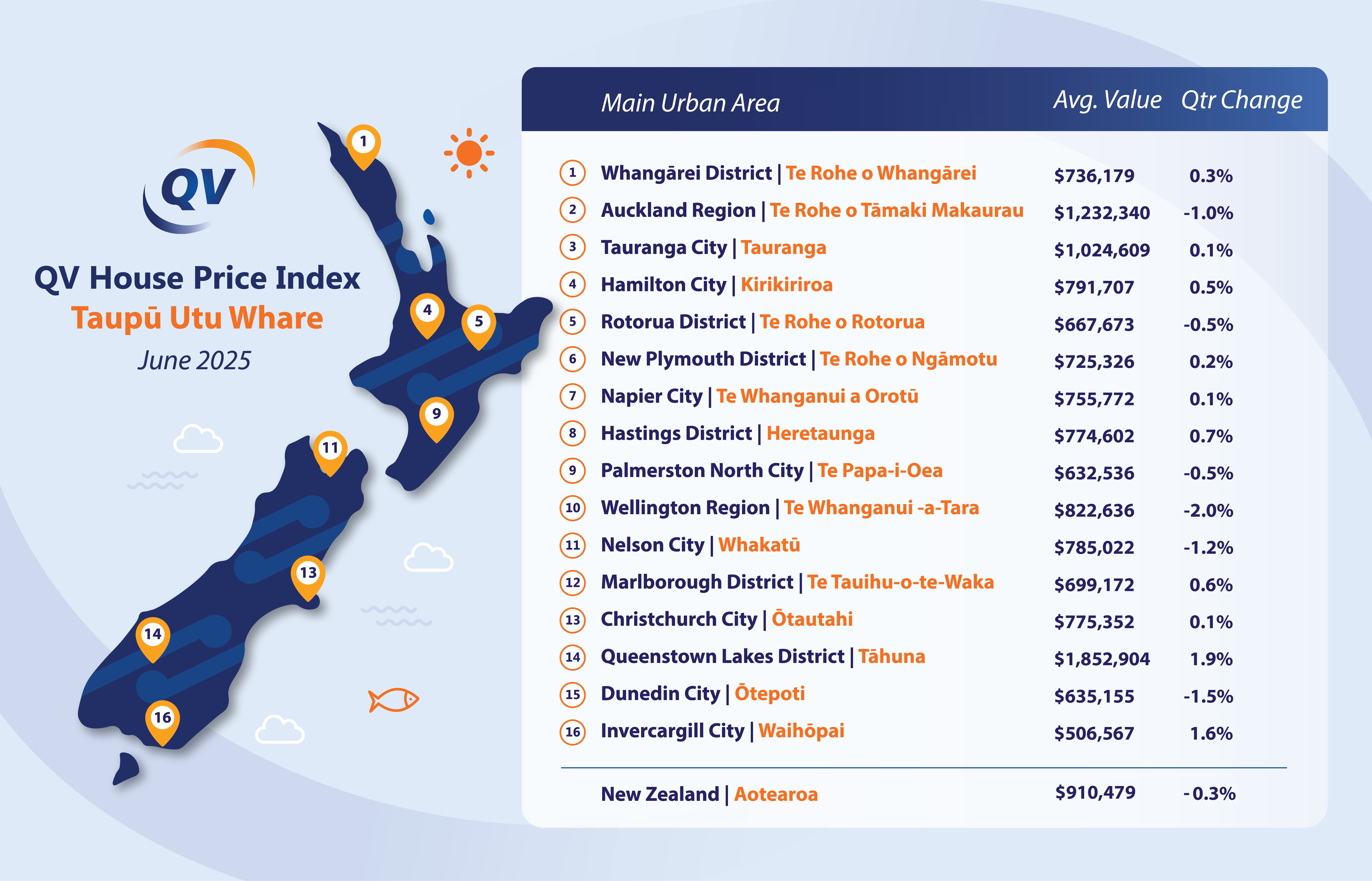National values dip 0.3%, but regional gains shine through, QV data shows

New Zealand’s housing market continued its slow recalibration in the June quarter, with the latest QV House Price Index showing a marginal national dip in average residential property values – but also emerging signs of buyer opportunity across regional areas.
The average home value fell 0.3% over the three months to June, bringing it to $910,479. That’s 0.6% lower than the same time last year and 14.5% below the market’s peak in late 2021.
Values rose in Queenstown, Invercargill, and parts of Northland and Waikato, while major cities such as Auckland, Wellington, and Dunedin recorded further declines. The figures highlight increasing regional divergence across the country.
“Regional divergence is becoming more evident, with more affordable markets recording notable quarterly gains such as Wairoa (12.6%), Gore (8.8%), Buller (6.2%), the Far North (5.8%) and Waitomo (5.2%), while others continue to track lower due to economic uncertainty and a cautious buyer pool,” said QV national spokesperson Andrea Rush.
Buyers take advantage of more stock, softening rates
Rush said that despite economic headwinds, affordability is improving for some, particularly first-home buyers and owner-occupiers targeting lower to mid-value areas.
“Some buyers may be anticipating lower rates, with bank activity back to mid-2022 levels after the market peak,” she said.
“However, it’s unclear how much of this reflects new purchases versus refinancing. Ongoing global conflict, economic uncertainty, and rising living costs are likely to limit any significant upswing in the near term.”
That caution is echoed in economist outlooks, with the prospect of further rate cuts still uncertain.
BNZ’s Stephen Toplis said the odds of a cut are “diminishing by the day,” though the bank still forecasts a 25bp move. Westpac expects the RBNZ to hold in July and ease in August, while Kiwibank’s Jarrod Kerr said the economy is still “crawling out of the recession” and key sectors remain “very weak.”
Auckland remains subdued despite strong listings
Auckland’s average home value fell 1% to $1,232,340 in the June quarter – 1.4% down year-on-year and 18.8% below the market peak. Only central Auckland saw an uptick (0.1%), while all other areas, including Manukau, North Shore and Franklin, declined.
“For now, buyers have the upper hand, with many agents continuing to report low attendance numbers at open homes. Some buyers are making cheeky offers to see what might be accepted in the current market,” said QV Auckland registered valuer Hugh Robson.
“New multi-townhouse developments also continue to be built across the city, adding to the options available for buyers and renters alike.”

Waikato gains continue, Waitomo leads
Hamilton’s average home value rose 0.5% to $791,707 – up 1.2% annually. The wider Waikato region also posted a 0.5% lift, with strong performances from Waitomo (4.9%), Waikato District (2.1%) and Waipa (1.8%).
“There’s been some renewed confidence among buyers and sellers as the OCR has remained lower for a sustained period,” said QV Hamilton registered valuer Marshall Wu.
“Overall, we’re still expecting values to post a modest rise in 2025, but it’s likely to be at a slower pace.”
Bay of Plenty, Hawke’s Bay mostly flat
Tauranga’s average value rose just 0.1% to $1,024,609. Across the wider Bay of Plenty region, values slipped 0.3%. Kawerau was the standout, up 3.0%, while Opotiki fell 6.6%.
“Most sellers are setting prices that align with market conditions, although some are entering the market with higher expectations before adjusting,” said QV North Island revaluation manager Sophie Treder.
Hawke’s Bay values remained flat in Napier (up 0.1%) and rose modestly in Hastings (0.7%). Wairoa surged 12.6% quarterly and 27.2% year-on-year.
Mixed performance in Wellington and the South Island
Wellington’s average value fell 2.3% to $844,599, with all metro areas posting declines. Despite June’s OCR cut, buyers remain hesitant.
“The decreasing interest rates have not yet coincided with positive property market growth,” said QV Wellington registered valuer Jack Whiteman.
“Employment uncertainty, especially in the public sector, and a healthy supply of property is the leading driver to this relatively flat property market.”
Christchurch recorded a 0.1% gain to $775,352.
“Sales activity appears to still be consistent, with good buyer demand for the region,” said QV Christchurch valuer Olivia Brownie.
Nelson and Tasman declined by 1.2% and 2.3% respectively, while Marlborough rose 0.6%.
“Price reductions are continuing, especially at the upper end of the market where some properties are still overpriced,” said QV Nelson/Marlborough manager Craig Russell.
Queenstown, Invercargill defy the trend
Queenstown Lakes values rose 1.9% in the quarter to $1,852,904 – 1.3% higher year-on-year and now 16.4% above the national peak.
“Buyer interest in Queenstown remains steady, supported by winter tourism and easing interest rates,” said QV Queenstown registered valuer Greg Simpson.
“Rising stock levels are giving buyers more choice while helping to keep values in check.”
Invercargill values lifted 1.6% to $506,567, with Gore up 8.8%.
“Invercargill’s property market remains active, with steady interest from first-home buyers and investors seeking well-priced homes,” said QV Invercargill valuer Andrew Ronald.



